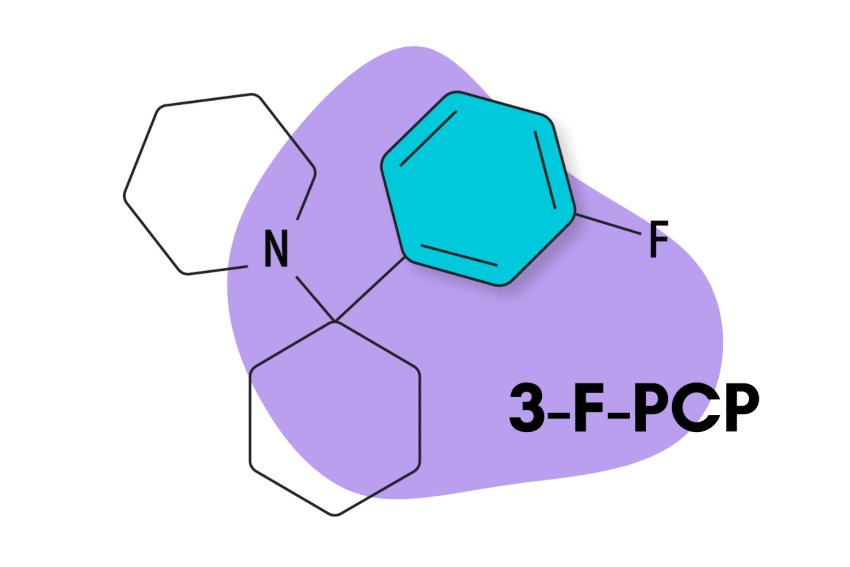Here’s A Pharmacological Breakdown of 3’F-PCP

What is 3’F-PCP?
3F-PCP — also known as 3-Flouro-PCP — is an arylcyclohexylamine and a derivative of PCP (phencyclidine). It was first discovered in Slovenia in 2020 and has since worked its way onto the designer drug market through various online vendors.
Chemically speaking, 3F-PCP distinguishes itself from PCP via the addition of a fluoro functional group.
Due to the relative novelty of this compound, there are virtually no available studies on its pharmacology, and even subjective user-generated information, usually found on popular recreational drug forums, is quite scant.
3’F-PCP Specs
| Chemical Name | 3’F-PCP |
| Level of Risk | Moderate to High |
| Most Common Side Effects | Psychosis, Seizures, Anxiety, Paranoia, Agitation, Confusion. Increased heart rate and blood pressure, Palpitations, Chest pain, and Difficulty breathing. |
| Duration of Effects | Four to eight hours |
| Estimated Threshold Dose | Unknown |
| Common Dose | Unknown |
| Legality/Status | Research Chemical |
| PubChem ID: | 398433 |
| CAS# | 89156-99-0 |
Tripsitter Safe 3’F-PCP Guidelines
- 🐍 I understand why arylcyclohexylamines should be treated with respect
- ⚖️ I’m familiar with the laws for arylcyclohexylamine class in my country & state
- 🍄 I’m familiar with and confident in the dose I’m taking
- 🧪 I’ve tested a sample of the substance I’m using with a drug-testing kit
- 💊 I’m not mixing any medications or other substances with 3’F-PCP
- 🏔 I’m in a safe & comfortable environment with people I trust
- 🐺 One of the members of my group is responsible and sober (AKA a trip sitter)
- ⏳ I have nothing important scheduled for after the trip
- 🧠 I’m in a sound & healthy state of mind
- ❤️ I don’t have any underlying health issues — don’t take 3’F-PCP if you have underlying heart, neurological, or psychiatric disorders
- 👭 Use the buddy system — 3’F-PCP can remove your inhibition and allow you to make unsafe decisions, always stay with people you trust, and never go out alone
What Are The Effects of 3’F-PCP?
As an analog of PCP, we can be reasonably sure as to the general psychoactive properties displayed by 3’F-PCP.
PCP and its analogs are known for having strong dissociative properties along with stimulant, euphoric, and hallucinogenic elements.
There are a lot of ways in which a dissociative experience can be described, but, as a general rule, PCP trips are often described as unwieldy, depersonalized, unpredictable and chaotic. In other words, it is a deeply strange, confusing, and hard-to-describe experience.
It’s also important to note that PCP is highly dose-sensitive, which is why it’s so important to know what specific analog you’re dealing with and if it’s a pure substance. Low doses are more stimulating and euphoric, while high doses are much more dissociating and hallucinogenic.
You might have heard some of the sensationalist news coverage on PCP – how it can turn people into ‘zombies’ and whatnot. This perception, as is usually the case, is highly alarming, but that doesn’t mean there isn’t some truth to it. PCP can be used for relative safety if the proper precautions are taken. But if they’re not, users have been known to become manic and even dangerous to themselves and others.
Is 3’F-PCP Addictive?
Unfortunately, there are no studies that directly attempt to assess the addictive potential of 3’F-PCP, which is why we have to look at PCP analogs more broadly.
Because PCP is nowhere near as popular as cocaine or depressants, the literature on PCP’s addictive potential is not as solid. However, human studies have indeed confirmed that PCP usage can produce physical tolerance, which is an important component when it comes to the development of addiction [1].
Tolerance, however, is not equal to dependence, as it does not mean that the physical symptoms manifest in feelings of displeasure if the drug is not consumed.
From a broad strokes point of view, it looks like PCP is definitely capable of eliciting symptoms of physical addiction — which makes sense as it does operate via a mechanism of action that can become addictive — but its overall addictive potential is less than, for example, cocaine.
When we look at PCP’s pharmacological effects, this result starts to make more sense. The profile of PCP can easily overwhelm a user, especially if it’s consumed in high doses, and cause an undesirable experience. This is much less the case with drugs like cocaine, benzodiazepines, and MDMA. As such, if a user does not enjoy the effects of a drug, they are far less likely to want to do it again, even if physical addiction symptoms have manifested.
References
- Pradhan, S. N. (1984). Phencyclidine (PCP): some human studies. Neuroscience & Biobehavioral Reviews, 8(4), 493-501.